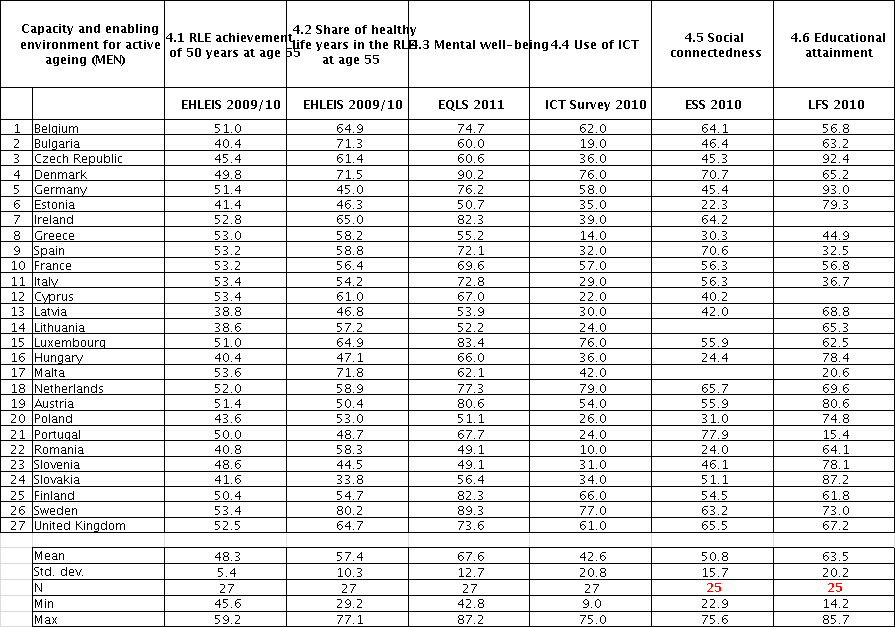4.1 Remaining life expectancy achievement of 50 years at age 55
Definition | RLE at 55 divided by 50 to calculate the proportion of life expectancy achievement in the target of 105 years of life expectancy |
Goal (rationale) | To capture the life expectancy aspect in determining the capacity for active ageing across EU countries. |
Source | European Health and Life Expectancy Information System (EHLEIS) |
Year | 2009/2010 |
Notes | For details, see http://www.eurohex.eu/index.php?option=ehleisproject |
4.2 Share of healthy life years in the remaining life expectancy at age 55
Definition | Healthy Life Years (HLY) a measure of disability-free life expectancy that combines information on quality and quantity of life. HLY measures the remaining number of years spent free of activity limitation. |
Goal (rationale) | Capture the proportion of years spent in good health in the remaining life expectancy at 55 as an indicator of the capacity for active ageing. |
Source | European Health and Life Expectancy Information System (EHLEIS) |
Year | 2009/2010 |
Notes | For details, see http://www.eurohex.eu/index.php?option=ehleisproject |
4.3 Mental well-being
Definition | Mental well-being (using EQLS 2011 and WHO’s ICD-10 measurement) |
Goal (rationale) | To capture mental well-being of older population aged 55+, so to complement the measure of physical health captured via the healthy life expectancy measure, with the help of an index that measures self-reported feelings of positive happy moods and spirits. |
Survey question | Q45a: I have felt cheerful and in good spirits
|
Source | EQLS |
Year | 2011 |
Notes | Variable is derived using WHO's ICD-10 measurement |
Caveats | The WHO-5 index has the limitation of being based on subjective response variable and thus it may be restricted in its international comparability. |
4.4 Use of ICT
Definition | Share of people aged 55-74 using the internet at least once a week. |
Goal (rationale) | This indicator aims to measure the degree to which older people's environments enable them to connect with others with the help of information and communication technologies, thus reflecting one aspect of their capacity for active ageing. |
Survey question | (Specific response category selected for this indicator in bold)
|
Source | Eurostat, ICT Survey |
Year | 2010 |
Notes | A higher number of older people using the internet points to a larger ability to communicate with others, and engage actively in society. While excessive use of the internet can be detrimental to one's health, such phenomena have been observed mainly for younger people thus far. It is therefore reasonable to associate the use of internet among older people positively with their capacity for active ageing (no cap necessary). |
4.5 Social connectedness
Definition | The indicator measures the share of people aged 55 or more that meet socially with friends, relatives or colleagues several times a week or every day. "Meet socially" implies meet by choice, rather than for reasons of either work or pure duty. The indicator measures contacts outside the household. |
Goal (rationale) | Social contacts are a key element of an active and fulfilling life, and also vital to human health, both mentally and physically. The specific measure focuses on social meetings by choice, thus duty or work related meetings are excluded. |
Survey question | (Specific response category selected for this indicator in bold) |
Source | European Social Survey (core questionnaire) |
Year | 2010 / 2008 (for LV and RO) / 2006 (for AT) / 2004 (for LU) / 2002 (for IT) |
Notes | The indicator measures contacts outside the household, thus in case the household size is large (multiple generations living together) the bulk of social contacts may take place within the household, rather than outside. |
Caveats | EU countries missing: LT, MT |
4.6 Educational attainment of older persons
Definition | Percentage of older persons aged 55-74 with upper secondary or tertiary educational attainment. |
Goal (rationale) | The indicator measures relatively high levels of education, but it is not restricted to tertiary education only, given the generally lower prevalence of tertiary education among the older people. Relatively high educational attainment reflects the acquisition of key competences in the shape of knowledge, skills and attitudes. These competences provide added value for social cohesion and active citizenship by offering flexibility and adaptability, satisfaction and motivation. |
Survey question | (Specific response category selected for this indicator in bold) |
Source | EU-Labour Force Survey |
Year | 2010 |
Notes | Education attainment level is defined as the percentage of people of a given age class (excluding the ones that did not answer to the question 'highest level of education or training attained') having attained a given education level: ISCED 3 (Lower/ upper) secondary education. |




